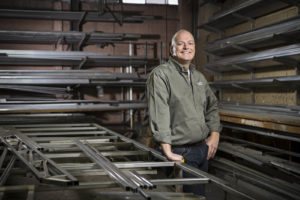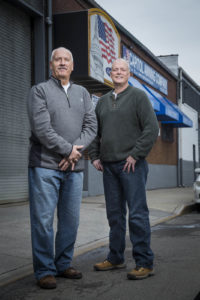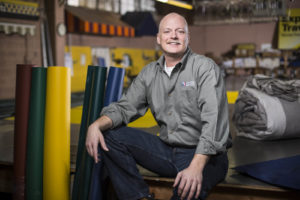
Michael Catalano treats his clients as strategic partners—and that keeps them coming back.
“We have a saying here: It’s not about the first job. It’s about the next job,” says Michael Catalano, CEO of Capitol Awning Co., Jamaica, N.Y. “And probably 90 percent or more of our work ends up being repeat business.”
Michael Catalano began working at his grandfather’s awning business when he was a child—eventually driving trucks around New York City as a newly licensed 16-year-old. (Even he shudders at that thought now.) And in 1996, Michael and his two uncles—Phil and Fred Catalano—took over the company. Fred eventually moved on to work on Wall Street, and though the three remain co-owners, Phil (president) and Michael (CEO) are the two who have remained involved in the day-to-day business operations—and they share the philosophy that the company is about relationships. “The whole premise of our company is based on our relationships with people and the quality of work we do,” Phil says. “We don’t have to advertise much anymore because of that.”
Time is money
In 2001, Michael became CEO of the family business, bringing with him upgrades in equipment and additional training for the sales team. “We had always been pretty state-of-the-art in terms of equipment but hadn’t got into the digital market yet. Digital printers were just getting cheap enough and good enough for mass use in awnings, so we bought into that and updated staff in how to use [them],” Michael says. “And our sales team—made up of really good people—just needed some more training.”
Michael also brought in a sales coach, who showed the sales team techniques to gently move clients toward a purchase. “He basically showed them how to ask for work without being a pushy salesman,” he says.
Boiled down, the sales coach taught the team how to value and make the most of their time. “He made us realize that if after you spend an hour with a client, come back to the shop and type up a proposal, you maybe have three or four hours invested,” Michael says. “What is the value of that time to you? Shouldn’t you value your time enough to call the customer up a couple of days later and ask what they thought of your proposal?”
Now, more than a decade later, Michael applies digital communication to the “value of time” sales approach. “I try to instill in our staff that instead of running out to see a customer initially, they ask the clients to send us a photograph of the site they want us to work on,” he says. “Then we can work something up and come to them with an idea in hand.”
 Walking the floor
Walking the floor
Michael spends the majority of his time doing project management for the more complex projects the company takes on. Sometimes he does the field measuring and sometimes other team members do, but he is typically the one to take the information to the AutoCAD department to ensure they understand what the goal of the project is. “I take the architect’s dream and put it on paper so we can send it back to them to be sure we meet the expectations and make sure we have everything we need to build it,” he says.
On days when Michael is in the office he walks the factory between five and eight times a day, to keep on top of how the projects are moving through the shop. “I just walk around, observe and ask what’s going on,” he says. “If I see any of the workers struggling with something, I’m right there to help with problem solving.”
Lights, camera, awnings
Michael says the company’s ability to be flexible and turn projects around quickly is a key component to its success—and one of the reasons it’s often called on to provide awnings and digital prints for television and movie sets. In December 2015 Capitol provided a series of awnings and digital prints for television’s “American Diner Revival” with Ty Pennington in approximately a three-day turnaround. “The staff has all been on TV—and they loved it,” Michael says. “We are able to keep our lead time to under a week, when the average awning company is running probably three to four weeks.”
The crew has also worked on awnings for Cinemax’s “The Knick”—about the Knickerbocker Hospital in New York City at the turn of the 20th century. The show needed to make modern buildings look like they did in the early 1900s, and Michael points out that the easiest way to hide air conditioners, rolling security gates and modern windows is to put awnings over them. Again, the ability to deliver the projects quickly is important, but there’s more to it than that. “It’s not just production turnaround,” Michael says. “It’s building the relationship of trust with them—because if you don’t make your deadline there could literally be a couple hundred thousand dollars on the line in shooting expenses due to putting a job back.”
 Serving the franchise market
Serving the franchise market
Overtime plays a part when projects need to wrap up in short order, but planning ahead and the repetitive nature of the company’s franchise work helps with time management as well. After years of working with franchises, including Dunkin’ Donuts, Subway® and Chock Full o’Nuts Coffee, Phil, Michael and the team have honed their expertise in providing the right balance of continuity and individual attention to the franchises. “There’s a tremendous comfort level on both sides because we’ve developed trust with them, and we have a lot of experience,” Phil says. “Many of these franchises are national accounts.”
Michael adds that among the benefits of doing franchise work is that the company can keep large amounts of fabric in stock. It’s cheaper that way, and they know they’ll need it. That also allows them to do work quickly when the need arises. Take, for instance, a recent project for one of their franchise clients. They had done a lot of work for him in the past, and when he realized that he forgot to order awnings until the day renovation started, he called Michael for help. “He’s a good customer of ours,” Michael says. “I had him send us photos of the building so we could do the rendering right away and write up a proposal for him and the corporate offices. He had that done within hours, and it was approved by the end of the day.”
Even with the cooperation of everyone involved, there wasn’t enough time to get the awnings done for the opening, but because Capitol also has a good relationship with the franchise corporate office, it got approval for the store to open without the awnings. And—a few days after that—the awnings were up.
The bottom line for both Michael and Phil—and their staff—is that they strive to make Capitol Awning a full service company that treats its clients like business partners, not like clients. “I remind the sales team that when they’re dealing with a customer who isn’t happy—and that does happen—that they should compromise,” Michael says. “We are going to do another job with them, so just find a compromise.”
5 Top Tips for working with franchises
- Establish a partnership with the franchise owner. Very few franchise owners own only one franchise.
- Be as full service as possible. (Provide banners, window films—whatever you can in addition to awnings.)
- Keep franchise-specific fabrics in stock so you can provide a quick turnaround.
- Make use of digital communication to maximize time investments.
- Keep in mind that the individual franchise is not the same as corporate. Just because one franchisee acts in one way doesn’t mean they all will.
What are the trends in graphics on awnings?
We’re seeing a trend away from so many graphics on awnings. Designers and municipalities are recognizing that people prefer more elegant minimalistic graphics. However, hardly a week goes by that we don’t digitally print some sort of custom color. Since the color palette is disappearing for what suppliers have in stock, we can still digitally print custom colors to meet the clients’ needs and expectations.
–Michael Catalano
What do you think is the biggest industry challenge currently?
Permitting and restrictions about the types of awnings you can install is becoming a bigger issue. Where it used to be predominantly a factor only in bigger cities, it’s now an issue with small municipalities as well. I think it’s largely a revenue-based decision, because a lot of towns and cities are hurting for income and it’s another revenue stream for them. In most cases, we use an expediter or a series of expediters to procure the permits. In New York City, where the average awning permit is $2,500, using an expediter is mandated.
–Phil Catalano
 Building a bus stop for less
Building a bus stop for less
When Delta Airlines at New York City’s JFK Airport tore down one terminal and moved to another, it needed a temporary bus stop—so it enlisted the help of Capitol Awning Co. “The architects had created a bus stop that was going to cost more than $5 million—and it would only need to last for five years and then it was going to be knocked down,” says Michael Catalano, Capitol’s CEO. “We have a long-term relationship with Delta and JFK so they called us in to figure out how to do it for less.”
Instead of using a fiberglass wall panel system, Capitol used a fabric panel wall, which shaved approximately $2 million off the project. The crew built an awning that was shaped somewhat like a golf club. The 16-foot, 4-inch-wide by 25-foot-long section turned 80 degrees into a section that was 22 feet wide and spanned 118 feet in length. The 35-foot-tall wall on the back of the shelter offered protection from the wind. The fabric of choice for the entire project was Herculite’s Patio 500® in cobalt blue.
“When you move away from traditional building materials to fabric structures you get really light weight and there’s a tremendous materials savings,” Michael says.
 TEXTILES.ORG
TEXTILES.ORG


